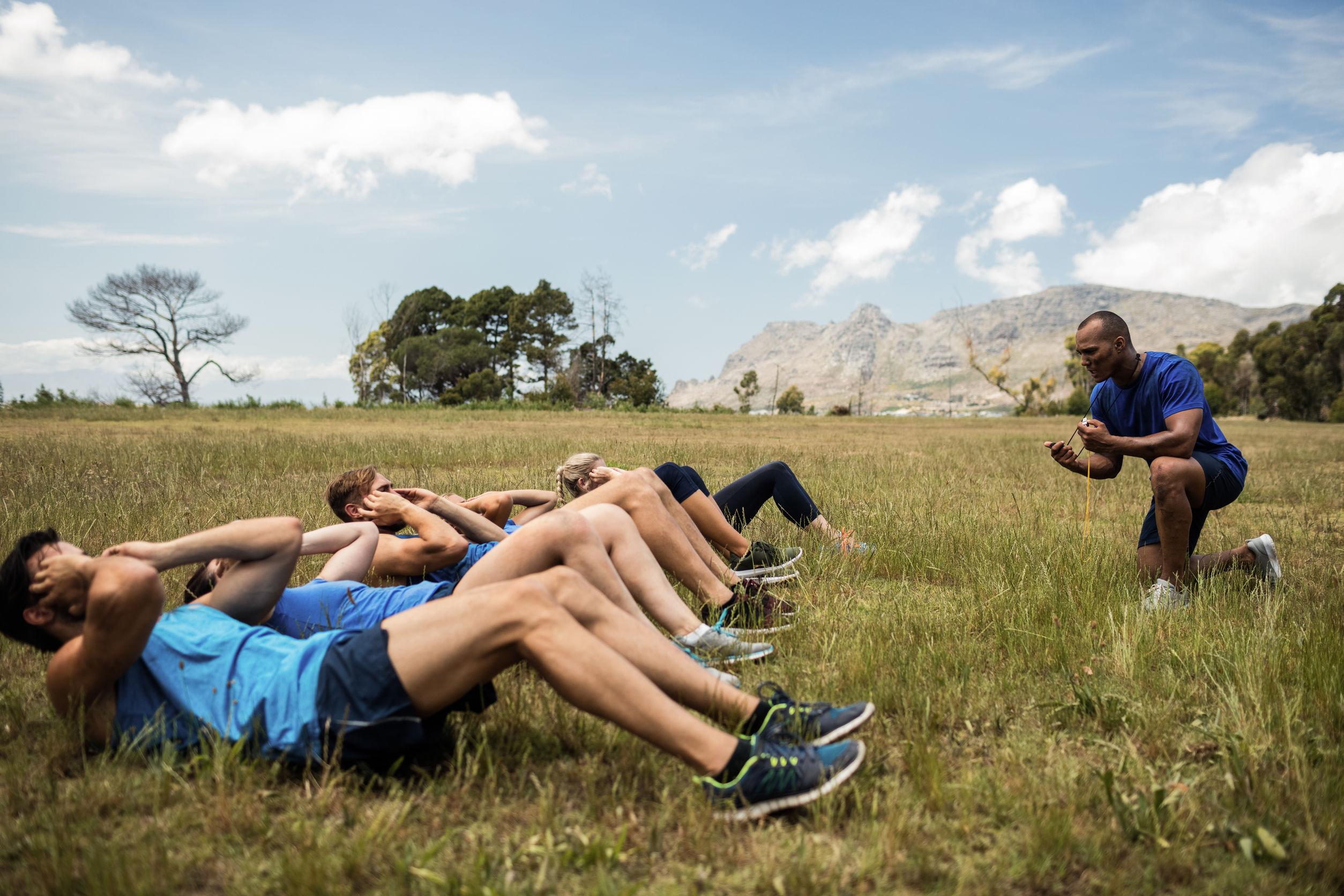”Illinois, how do you recover after exercise? Do you know anything about recovery science? Sports recovery is a relatively new field of research, but you can learn about the foundations in this week's article. We hope you find this helpful!
Reading time: 9 Minutes
MWi Hacks:
- Understand a principle based approach to recovery that not only applies to athletes but to our military and Veteran community as well
MWi Summary:
- While recovery science is in its early stages, applying recovery principles can help reduce injuries and overtraining.
- It is more important to recover deeper than it is to recover faster.
- Foundational recovery principles include sleep, nutrition, and active recovery.
Sport recovery is more complicated than whether ice baths are outdated or which compression socks to buy. Even though the science of recovery is in its very early stages, there are some great studies on athletes that are making a difference. The seven principles of recovery explained in this article will help you improve training outcomes while reducing injuries and overtraining.
When looking at all of the information on recovery, it helps to think about the global concept and then consider the very narrow details that add up to make a difference. I help you do this by breaking past superficial recovery discussions, guide you on the foundational and changing science, and describe techniques that make a difference. I also share timeless principles of training and recovery that you’ll likely find more useful.
The seven principles are not original ideas of mine but are rather a collection of wise advice from sport scientists, coaches, medical professionals, and athletes.
The Science of Recovery is Embryonic
The answers to sport recovery are more complex than a simple yes or no. I cringe when I read most articles on recovery and regeneration in sport because they parrot bad research or take a practice out of context. While great investigations into recovery have shed light for coaches over the last few years, we still don’t know everything about athlete recovery. We still need to know how the lymphatic system works and appreciate monitoring so we can prevent overtraining. Every month, a cold water immersion study shows disappointing results, and then once in a blue moon come results that are conflicting and surprising.
The core problem to understanding recovery is that we are stuck with antiquated models of what constitutes recovery and, more importantly, which variables we need to manage over time. Blood parameters like creatine kinase are okay for assessing muscle damage. Evaluating repair, however, is more complicated and requires more than evaluating one biomarker test taken a few days after hard training.
1. Time Rules Everything
You don’t want to speed up recovery. You want to remove unnecessary friction points and barriers to the body during the process. If you take away one idea from this article, it should be this: it’s far better to recover deeper than it is to recover faster. With training, coaches are likely to value the next hard session, but they need to wait with patience.
While the number of good workouts does matter, it’s better to take a few sessions out of the count and enhance the remaining sessions by resting. The classic hard-easy University of Oregon system is well-known, but adhering to the east side of the equation isn’t popular when winning matters. The name of the game is to wait for the right time to hammer a workout.
The human body is designed to self-repair, and trying to speed up the process is not likely to work. The best way to recover is to avoid training hard too early, which means giving athletes time to restore their resources. The adage “time heals” is correct, but it hardly completes the picture when referring to athletes. Taking time off is not the same as time performed in a different loading threshold.
Most coaches see easy workouts as scaffolding, or placeholder sessions, between the “good stuff.” It’s true that technically much of the easy sessions is composed of training that doesn’t “make” the athlete, but many of the hard sessions “break” the athlete. It’s helpful to research lighter forms of exercise to see how they make a difference in building a wellness platform for your athletes. While it’s important to pursue adaptations to push the body, searching for answers and clues with less demanding sessions creates a comprehensive training plan.
Later in the article, I’ll cover active recovery and its necessary details. For now, the main theme to keep in mind is that patience is truly a virtue. Waiting for a full recovery isn’t easy. There were plenty of times when I was too conservative and didn’t get the needed work in, and plenty of athletes stagnated. But, while it hurts the ego that many athletes could have trained harder and perhaps performed better, it’s important that injury rates were never an issue when I was patient and took my time with them.
2. Load Specificity Matters
We should never represent the body as a line plot over time, which we tend to see with models from sport scientists and high-performance managers. While the acute-to-chronic workload ratio does seem to predict injury, what happens when an athlete is injured while their ratio landed in a safe period? Most load management calculations summarize a daily training load as a volume metric. And while this is useful and encouraged, it doesn’t solve discrepancies between different body systems and training.
For example, how does weight training during an in-season NFL week interact with practice? How do we take into account loading the Achilles tendon with new cleats and the aerobic system of a very fit athlete? Even if we could overlay dozens of line plots showing the body’s different physiological and anatomical systems onto one chart, eventually a coach still has to decide on a training program that is never ideal.
Not only does a coach need to know how each system of the body recovers and how long it takes to remodel, everyone involved must know the sequence of sessions that creates the best winning formula. Reaching a compromise between a practice’s tactical and physical design isn’t easy, as it must show a balance that enables a team or athlete to win.
Take a healthy perspective for the load specificity principle by looking at both the big picture of the season and the details of what is holding an athlete back—usually connective tissue. Tendons and ligaments are the slowpokes in training, and in addition to patience, recovery is about knowing what structures of an athlete’s body need rest or a change in training.
3. Monitoring Training and Recovery
Creating a winning training model requires monitoring and planning. At times I’ve gone off the deep end and tried to measure everything, although falling on the other side of the spectrum is more common. Measurement is a shunned concept because it’s intrusive and annoying or it’s convenient but expensive.
Monitoring recovery is not as precise and accurate as measuring training load, so most of the physiological and field tests only estimate the severity. Some coaches rely strictly on subjective indicators like wellness questionnaires and conversations to screen out athletes who are too tired to go hard in a session. While it’s good to use surveys and subjective feedback, feelings are not the same as biomarkers and specific organ systems. Eventually monitoring needs to involve a combination of things, including the central nervous system and the autonomic nervous system.
If a coach wants to make a change and monitor one variable, look at mood and let the athlete communicate in an open format. While I like robust and complete monitoring programs, I’d rather see success with something small and sustainable than watch a program that looks perfect on paper crash and burn.
Coaches who don’t do much monitoring should read the research anyway as plenty of takeaways exist from good scientific publications. Although the conclusions and discussions at the end of studies are speculations and opinions, researchers sometime make suggestions that are useful even if you aren’t collecting the same data.
Skipping the measurement and attempting interventions in advance is still guesswork, so it’s up to the coach to extract similar data from the athlete without creating backlash or annoyance. A good rule of thumb to follow is how much information is necessary. I’d rather have data that makes a better program the next year than a monitoring program that makes all the decisions this week. General sport science and patience are important, and measurement from monitoring adds precision that we may never achieve with trial and error.
4. The Sleep Paradox
Sleep doesn’t support heavy training, it exposes it. Most coaches encourage sleep to facilitate recovery from hard workouts, but this is a poor philosophy. Instead of treating sleep like an eraser for fatigue, respect it by placing athletes in a position to sleep better.
After years of sleep research, the field of sports performance understands and values the science of sleep and its effects on the body. What we also need to appreciate, however, is the effects of training design on the ability to harness the benefits of sleep. The research is crystal clear that overreaching impairs sleep. If we don’t monitor sleep and manage training properly, bad planning and poor training evaluation neutralize sleep’s restorative benefits.
The oversimplification of sleep and recovery is the most frustrating of all the training factors for me. I agree that sleep hygiene and environment matter and support sleep. But there’s too much effort chasing perfect temperatures and pillows when the culprit is likely the training itself. This is a hard truth to swallow: we can get better sleep by focusing on training—not getting more sleep or deeper sleep. The research supports this notion.
Sleep monitoring works, but we’ve seen a push lately to avoid measurement, remove technology, and put aside science. I suspect those who don’t like data are worried about the transparency of objective feedback, or they’re in a position where they’re responsible for the things that are measured but don’t have the political power to make changes.
You’re not in a doomed situation if you can’t apply interventions, though it’s certainly frustrating. Remember, you have to start somewhere; not trying will never solve a difficult and complex problem. And while sleep is a major factor, don’t treat it like a savior. Be the sleep hero and manage the variables that contribute to quality sleep as much as possible
5. Understand Sports Massage and Therapies
Soft tissue therapy has a hard rep and deservedly so. The science of evaluating tissue performance is usually primitive, using algometers or invalid measures like blood biomarkers. In my article on overhyped topics in sports performance, I pointed out that while fascia is not a myth, it’s not more special than any other system of the body.
One system taken for granted, though, is the lymphatic system. With recent research on the interstitium system, we may start to understand how tissue recovers beyond myofibril repair and glycogen restoration. While we seem to be stuck on 1990s massage research, some new research using elastography and tensiomyography is really showing progress. Anyone who says massage doesn’t work usually doesn’t have a response when presented with discussions on evaluating soft tissue. Conversely, a lot of therapies exist simply because of marketing hype.
How massage works is tricky. The main challenge is knowing which therapists are qualified to be studied. Like research on recreational athletes that fails to show viable information for coaches, studies using a local therapist from a general massage clinic don’t mean anything for elite athletes, which is precisely why many in high-performance sport are frustrated.
We do know that massage can replace many typical warm-ups and may be appropriate for athletes doing rounds in championship meets or athletes who are not practicing hard between games and need something to get through the day. Plenty of research has shown mixed results with athletes, which actually provides a great opportunity if we can align soft tissue therapy with the correct purpose. And although a relaxing massage may not be great for performance, it may help change perceived recovery. Real biochemical benefits do exist from massage, including those that trigger gene activation.
Therapies that don’t use human touch also matter, including compression methods, electrical muscle or nerve stimulation, and thermotherapy. Combined with environmental support like retreats to nature and changes in venue, classic modalities may provide more than good feelings. The combination may actually target recovery that’s not commonly measured in scientific research conducted at universities and hospitals.
Down the road, I believe more research will show that massage works through a connection between athlete coordination and a therapist’s knowledge of which buttons to push. Of course, we won’t see the outlandish claims some therapies are declaring. It’s safe to say, however, that we may see fresh studies proving that more than just rubbing is going on in the neuromuscular system.
6. Nutritional Support and Timing Strategies
Today coaches have better information to work with than the oversimplified equation of matching macronutrient calories and micronutrients that was popular decades ago. Periodized nutrition, functional sports beverages, adaptogens, and concussions are areas that a nutritionist applies today. When nutritionist services are not accessible, responsibility for sports nutrition falls on the coach.
Coaches need to put aside glycogen restoration and simple things like protein consumption and raise the nutrition standards for recovery. With the wealth of science available, coaches can support athletes with more than hydration from sports drinks. They can add inexpensive blood testing and custom meal plans due to technology advances like smartphone apps. Also, while scientific evidence on post-workout drinks may not support their use, the practical needs of administering an athlete’s diet does.
What we know now is that nutrition is highly individual. Most of the new research on nutrition is at the cellular level and beyond, including genetic data. Ten years from now we’ll have a better idea of which current trends are hype and which matter.
7. Active Recovery Details
In my earlier article examining active recovery studies, my conclusions paralleled the authors—immediate low-intensity work is great for those who want to gauge their body slowly after heavy training and don’t expect anything the next day.
But one issue still needs to be addressed for team sport athletes: we need a study that matches the right modalities to an appropriately loaded recovery workout scheme we can use between hard sessions so we can plan enough training for the sessions. Active recovery only works between hard workouts, not at the end of one. For team sport athletes, the tricky part is knowing what to do after a hard session because team sports are cursed with the needs for strategy and tactics. And it’s hard to perform complementary training outside the practice grounds.
Because managing and designing the ultimate microcycle, or set of possible microcycles, is the Holy Grail, the most pragmatic way to help team sports is to find a way to load properly and meet the needs of game preparation. The devil truly is in the details. Most active recovery workouts are junk rep circuits or aerobic workouts that are either busywork or are too hard.
Solving the sweet spot with loading is not hard. It means creating a sequence that’s satisfactory in strategy so the team coach is happy and also follows the principles of overload to satisfy the performance staff. A team coach is usually more focused on which plays an athlete needs to perform correctly. But they often do too much, which creates fatigue that encourages the athlete to do things wrong.
The future will focus on skill and tactical acquisition that merges physical loading, not general training sport science. Active recovery fits both Olympic and team sport by filling the gaps and not deepening the week’s training fatigue. Athletes need recovery training to keep them fit, and we need to design the recovery workouts with the same effort we use for the primary high-intensity and challenging sessions.
More on the author:
Coach Valle has coached Track and Field at every level, from high school to the Olympic level in the sprints and hurdles. He has had the privilege of working with great athletes that have been All-American and school record holders. A technology professional, Coach Valle has expertise in performance data as well as an understanding for practical application of equipment and software. Carl is currently the lead sport technologist for SpikesOnly.com, and focuses his time on testing elite athletes and using technology to help everyone on any level of human performance reach their goals.






